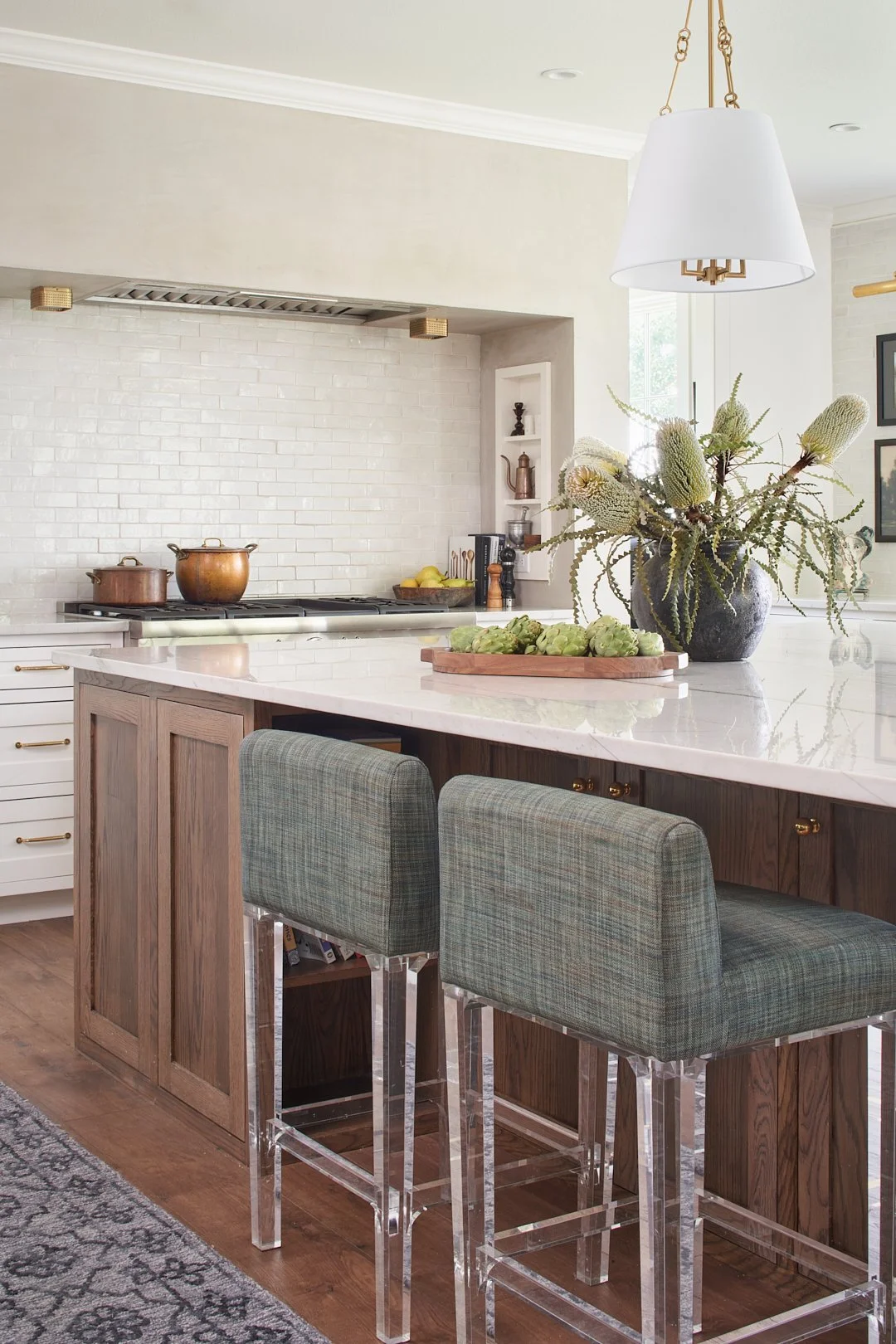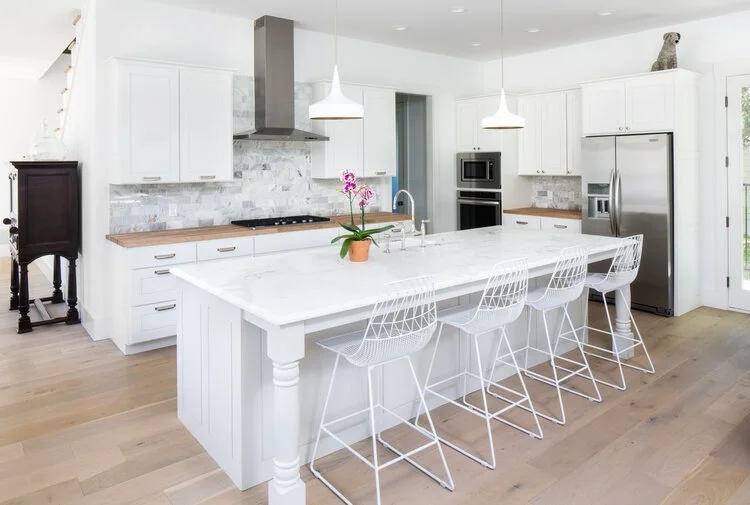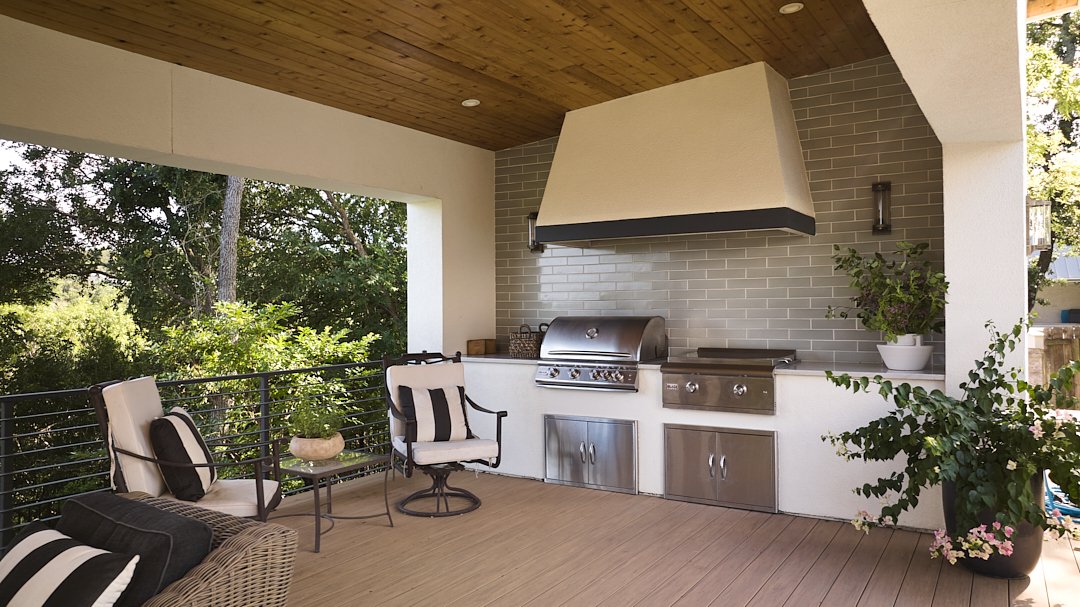The Top 7 Types of Range Hoods (And 1 to Avoid)
Our Austin Architects Share Their Favorite Range Hood Styles and One They’d Never Use
Range hoods make for a beautiful kitchen focal point and provide the practical necessity of pushing smoke and smells out of the home. But do you know which type of range hood is the best fit for your kitchen? The choice comes down to layout, function, and aesthetics. Our Austin architects have broken down the top 7 range hood styles to help you better decide the best fit for your kitchen. Plus, we reveal the one type of range hood we’d never use in a project!
Vented vs. Non-vented Range Hoods
Before we get into the various styles of range hoods, let’s review the functional difference between vented and non-vented hoods.
Vented Range Hoods
Vented range hoods are also called ducted or external venting hoods. These hoods exhaust air to the outside through a duct system, eliminating smoke and odors from the kitchen.
Non-vented Range Hoods
Non-vented range hoods are also called ductless or recirculating hoods. Instead of exhausting air to the outside, these hoods pull air through a filter and recirculate it back into the kitchen. While the filter captures some of the smoke and odor, it is less effective than redirecting it outside through a vent.
Our Austin architects recommended vented hoods over non-vented hoods because they can better manage smoke and odors. Make sure to plan ahead in your design to accommodate a vented hood, especially when renovating an older home that might have more architectural constraints.
7 Types of Range Hoods for Your Kitchen
Here are the seven most popular range hood styles and their features.
1. Wall-mounted Range Hood
Wall-mounted range hoods are one of the top choices among homeowners. These hoods feature a bell-shaped canopy and sometimes include a chimney-style stack for added detail. Wall-mounted hoods can be purchased from various appliance brands and attached directly to the wall above the stove. They come in a range of finishes, but stainless steel is one of the most popular options. Wall-mounted hoods do not allow space for upper cabinets over the stovetop.
2. Under-cabinet Range Hood
Under-cabinet range hoods are smaller and more discreet than wall-mount hoods. Their smaller size allows them to easily fit underneath an over-the-stove cabinet, allowing for added storage and a more streamlined design.
3. Island Range Hood
Island range hoods are specifically designed for stovetops placed in a kitchen island. Similar to wall mount hoods, they feature a chimney stack and canopy. However, they are finished on all sides so they can hang in the center of the room. While island hoods can serve as a focal point, they can also obscure sightlines. So, be aware of their size and height throughout the design process.
4. Retractable Downdraft
Unlike traditional range hoods installed over the stovetop, retractable downdrafts are discreetly hidden in the countertop. Downdraft vents remain flush with the counters when not in use. At the push of a button, they rise up around 14 inches behind the cooktop to vent smoke and odors through ducts beneath the floor. Retractable downdrafts are great options for island ranges that don’t affect sight lines. While downdrafts are sleek, they may be less effective than a traditional range hood. When the space allows, an over-the-stove hood is the preferred choice.
5. Slide-out Range Hood
While some homeowners like the range hood to be the main focal point, others would prefer it to disappear. Slide-out range hoods do just that. This hood style mounts seamlessly under cabinets and recedes from view when not in use. When it’s time to cook, you simply pull it out.
6. Custom Range Hood
So far, all the range hoods we’ve discussed can be purchased from major brands to match your appliance package. However, some homeowners desire a custom design that really stands out as the main focal point, especially for open-concept kitchens. That’s where custom range hoods come in! Your architect can help you design any type of range hood imaginable. Popular hood profiles include bell, barrel, and box shapes. Materials can range from wood and metal to plaster and stone. Plan ahead with your architect to create a design. Typically, we like to make the range hood a little wider than the stovetop for a more dramatic effect. Once the custom design is completed, select a range hood insert that meets your specifications.
7. Range Alcove
Another popular custom hood option is a range alcove. Range alcoves feature two walls on either side of the stove that extend up to a drop-down that contains the vent hood insert. Typically, these feature an arch or other design detail like a beam. Many range alcoves have added storage shelves built into the walls, flanking the stove for easy spice and oil storage. This design makes for an eye-catching focal point and a cozy feel.
How to Choose the Right Range Hood for Your Kitchen
There are many beautiful range hood options out there. Consider the following factors to help narrow down your decision.
Range Placement
Your range placement will affect which hoods are possible in your kitchen design. For example, cooktops placed in islands or in front of windows might be unable to accommodate a hood. In these cases, a retractable downdraft is the best option.
Type of Range
Did you know that your stovetop might not even require a range hood? Usually, building codes don’t require vent hoods for electric or induction cooktops. While only gas ranges require ventilation, many homeowners still want the aesthetics and function of a range hood.
Overall Style
Different range hoods fit different architectural styles. For example, a custom plaster hood takes on a traditional or Mediterranean-inspired style, whereas a stainless-steel hood feels more contemporary or industrial. Consider the overall style of your home when making your selection.
The Range Hood Style We’d Never Use
So, what’s the range hood style our Austin architects avoid at all costs? It’s the microwave hood combination! While this style promises two-for-one convenience, it tends to lack function and doesn’t create a visually appealing kitchen focal point. We recommend tucking the microwave away in a butler’s pantry and making a show-stopping custom hood design.




